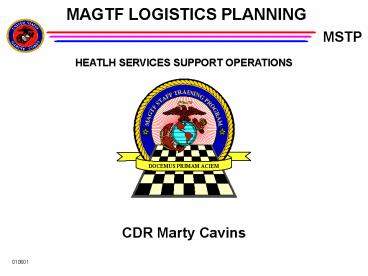CDR Marty Cavins - PowerPoint PPT Presentation
1 / 27
Title:
CDR Marty Cavins
Description:
Discuss how medical planners need to be integrated into the MCPP and the ... Barring any new 'medical miracles' the greatest impact we can have will be on ... – PowerPoint PPT presentation
Number of Views:70
Avg rating:3.0/5.0
Title: CDR Marty Cavins
1
MAGTF LOGISTICS PLANNING
HEATLH SERVICES SUPPORT OPERATIONS
- CDR Marty Cavins
010601
2
PURPOSE
- Develop a knowledge of combat epidemiology
- Gain an awareness of the Patient Movement
system, which includes Medical Regulating - Discuss how medical planners need to be
integrated into the MCPP and the interactions
they need at the MAGTF, component, and joint
levels
3
REFERENCES
4
HSS MISSION
MSTP
- The Health Service Support (HSS) mission is to
minimize the effects that wounds, injuries, and
disease have on units effectiveness, readiness,
and morale. (MCWP 4-11.1) - The HSS units job is to help the Commander
accomplish his mission. - BOTTOM LINE Provide for a healthy fighting
force supported by a combat ready health care
system.
5
CIVILIAN VS. MILITARY TRAUMA
Civilian
Combat
- Blunt Trauma
- Initial evacuation is to a trauma center
- Treatment is completed at one facility, by one
team of HSS professionals - Air transport is dedicated
- Penetrating Injuries
- Initial evacuation is to an aid station
- Treatment at multiple facilities thousands of
miles apart, by many different HSS professionals - Air transport is frequently lift of opportunity
6
CAUSES OF DEATH
(From the Wound Data Munitions Effectiveness Team
(WDMET) study in Vietnam)
- Major treatable cause of death from combat
injuries is bleeding to death
7
TIME - WOUNDING TO DEATH
(From WDMET)
8
DISTRIBUTION OF WOUNDED
(From WMDET)
100
Some will live no matter what you do Some
will live or die depending on what you do Some
will die no matter what you do
Slightly WIA (65)
35
Seriously WIA (15)
20
KIA (20)
0
9
WHAT DOES THIS DATA MEAN?
- Barring any new medical miracles the greatest
impact we can have will be on the seriously
wounded group - Earlier surgery for those who would quickly bleed
to death is where we need to put the medical
resources to make an impact
10
SIGNIFICANCE OF DISEASE
US Army Hospital Admissions, shown as a percent
11
SIGNIFICANCE OF DISEASE
- DNBI accounts for most man days lost in combat
- Less mortality from disease
- Logistically easier to support treatment of
disease - Less urgency in initial treatment compared to
injuries - More potential for return to duty
- Can eliminate or reduce with a good preventive
medicine plan
12
WHAT IS MEDICAL REGULATING?
Patient Movement
Tactical and Strategic Evac
Primary and Secondary Evac
Med Evac
Forward Aeromedical Evacuation
Dust Off
Medical Regulating
Patient Evacuation
Aeromedical Evacuation
13
DEFINITIONS
Medical Regulating The actions and
coordination necessary to arrange for the
movement of patients through the echelons of
care. This process matches patients with a
Medical Treatment Facility (MTF) which has the
necessary HSS capabilities, and it also ensures
that bed space is available. (MCWP
4-11.2) Patient Evacuation The process of
moving any person who is wounded, injured, or ill
to and/or between MTFs. (MCWP
4-11.2) Patient Movement The act or process
of moving a sick, injured, wounded, or other
person to obtain medical/dental care or
treatment. Decisions made in this process
involve coordination between the sending MTF, the
gaining MTF, the MRCO, the LF PEO, and/or the
GPMRC/TPMRC. (MCWP 4-11.2)
14
ELEMENTS OF PATIENT MOVEMENT
- Tactical or Clinical decision that the casualty
needs to move - Finding a medical treatment facility with an
available bed and appropriate capability - Finding a way to get the casualty to the above
facility
15
EVACUATION POLICY
- Theater evacuation policy is set by SecDef in
coordination with the geographical combatant
commander (CINC) prior to OPLAN execution - Upon execution, the theater evacuation policy is
adjusted by the CINC as needed - Generally expressed as in number of days
16
EVACUATION POLICY
- Considerations in planning the evacuation
- policy
- Number of patients
- Means of evacuation
- Availability of replacements
- Availability of theater resources
- Timeliness (response, mobilize, build up)
17
TRAC2ES
- TRANSCOM Regulating and Command and Control
Evacuation System (TRAC2ES) - Combines the elements of finding a bed and
finding a way to move the patient (lift bed
planning) into one automated system - Lift bed planning (current 400 pts/30 min,
TRAC2ES 1,750 pts/30 min. - It establishes patient In-Transit Visibility
(ITV) within 5 min. - Operational by OCT 2000
18
PLANNING HSS
- What is the interaction of HSS in the planning
process?
- Significant contributions or important
situational awareness to take away in each step
19
MISSION ANALYSIS
20
COA DEVELOPMENT
21
COA WAR GAME
22
COA COMPARISON DECISION
23
ORDERS DEVELOPMENT
24
TRANSITION
25
MAGTF HSS ASSETS
26
JOINT HSS ASSETS FOR MAGTF
Air Ambulance Co.
- Joint HSS assets available that we may need to
include in planning
27
SUMMARY
- Developed a knowledge of combat epidemiology
- Gained an awareness of the Patient Movement
system, including Medical Regulating - Discussed how medical planners need to be
integrated into the MCPP and the interactions
they face at the MAGTF, component, and joint
levels




















![[DOWNLOAD]⚡️PDF✔️ Anton Marty and Contemporary Philosophy (History of Analytic Philosophy) PowerPoint PPT Presentation](https://s3.amazonaws.com/images.powershow.com/10051439.th0.jpg?_=202406091110)
![[DOWNLOAD]PDF Anton Marty and Contemporary Philosophy (History of Analytic Philosophy) PowerPoint PPT Presentation](https://s3.amazonaws.com/images.powershow.com/10052112.th0.jpg?_=20240610014)









